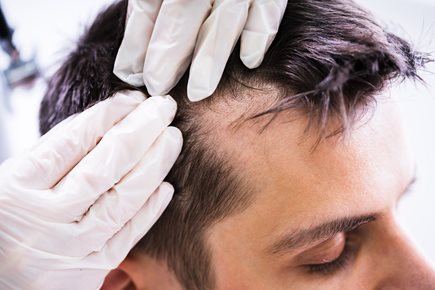Thinning Hair and Hair Loss: When to See a Dermatologist
 “By the time men first notice they’re losing their hair or that their hairline is changing, about 50% of their hair follicles have been affected,” said Surgical Hair Restoration Fellow Rahil Roopani, MD, of Leavitt Medical Group. “This generally can happen as early as their 20s, with most men starting to care about it in their 30s.
“By the time men first notice they’re losing their hair or that their hairline is changing, about 50% of their hair follicles have been affected,” said Surgical Hair Restoration Fellow Rahil Roopani, MD, of Leavitt Medical Group. “This generally can happen as early as their 20s, with most men starting to care about it in their 30s.
Dr. Roopani is passionate about providing a holistic, patient-centered approach to hair loss that combines the art and science of medicine with scientific research.
“For those who notice they’re shedding more than the average 100 - 150 scalp hairs a day, see a receding hairline, balding at the crown, or have a strong history of male pattern baldness in their family, seeking the help of a dermatologist early on will likely have the greatest impact on reducing or reversing hair loss.
“In androgenetic alopecia (in men also known as male-pattern baldness), susceptible hair follicles (usually at the top of the scalp including the vertex) will progressively go from producing thick "terminal" hair to thin "vellus" hair. This will continue until eventually the follicle will no longer exist,” said Dr. Roopani.
”The goal of therapy is to make thinning, vellus-type hair into terminal, more thick and natural-looking hair. Some thinning hair can be regrown in a thicker, more robust fashion, however this will take time and can be frustrating to some patients.”
What treatments can help regrow hair?
“Therapies are different, and there’s no silver bullet for everyone,” said Dr. Roopani. “Understanding the cause of your hair loss is important. While male pattern hair loss (also called androgenic alopecia) is one of the most common reasons men lose their hair as they get older, your dermatologist will look at all the factors that may be at the root of your problem. These can include common factors such as genetics, age, trauma, stress, and less common factors such as nutritional deficiencies, hormonal imbalance, pro-inflammatory states, and underlying health conditions such as metabolic syndrome, insulin resistance, and cardiovascular disease.”
Dr. Roopani and a team of hair loss experts, including Advanced Dermatology’s Natalie Kash, MD, a board-certified dermatologist with a special interest in hair loss, and world-renowned hair loss expert Dr. Matt Leavitt, who is the Founder and Executive Chairman of Advanced Dermatology, have authored a comprehensive report which will soon be published nationally as an article in the journal Dermatologic Clinics. The article, entitled “Clinical Patterns of Hair Loss in Men: Is DHT the Only Culprit?” looks at the many different factors which may have an impact on the treatment of hair loss in men.
“Once your doctor understands what factors may be impacting your hair loss, he or she will make recommendations. While many of these therapies work better in combination, some require multiple visits to your dermatologist, and all require some level of compliance, as the effectiveness of most treatments can reverse once they are stopped.”
BOOK ONLINE 866-400-3376
Most common treatment options for hair loss
Some of the therapies for thinning hair or hair loss, from simplest to most sophisticated, include:
Shampoos and conditioners formulated to create denser hair and improve the health of your scalp and hair. The hair care experts at Advanced Dermatology and Cosmetic Surgery have created proprietary Proscriptix FX® hair and scalp therapy products which combine specialized medical expertise and validated science to effectively address your concerns.
Daily supplements and vitamins that are professionally formulated to nourish hair from the inside out, and target the underlying causes of compromised hair follicule function.
Minoxidil (Rogaine®) is an over-the-counter topical medication that works at a molecular/cellular level to widen blood vessels to deliver more oxygen-rich blood to the hair follicles. It also helps increase the size of hair follicles, which promotes the growth of thicker, stronger hairs. In addition, the topical treatment shortens the resting phase of hair growth, which means your hair stays in the growth phase longer.
Finasteride (Propecia®), is a prescription medication taken orally every day, and is also used to treat benign prostate disease. In a significant number of men, finasteride promotes scalp hair growth and prevents further hair loss.
Other oral medications for hair loss include spironolactone (Carospir®, Aldactone®) and oral dutasteride (Avodart).
Plasma Therapy (PRP) for hair loss is a safe, effective treatment that uses your body’s own natural ability to prompt hair growth.
Low-level laser therapy (LLLT), also known as Red Light Laser Therapy or cold laser therapy is a safe, well tolerated non-surgical hair restoration therapy that strengthens hair follicles, thickens thinning and slows down hair loss.
Surgical hair restoration is the only permanent treatment option for androgenetic alopecia (male pattern hair loss).Your Advanced Dermatology hair restoration and hair transplant experts can help you schedule an appointment with a hair transplant surgeon to evaluate your needs.
“Many men think their appearance directly impacts what is happening in their life. When they lose their hair, they feel like they have lost a part of themselves. By talking with a dermatologist early about their hair loss, many men can see positive changes in their overall health, outlook and confidence.”
To learn what may be at the root of your hair and scalp conditions or to learn more about treatment options, schedule an appointment today.
BOOK ONLINE 866-400-3376